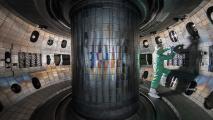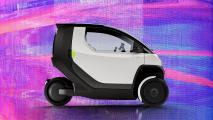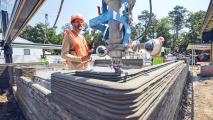
Materials
Though we live in a digital age, material science has shaped history—and it’s far from over. From quantum computers to fusion reactors, breakthroughs in materials will drive the next technological frontier.
More
This luxury solar electric car could go 7 months without recharging
Dutch startup Lightyear expects to begin delivering a $254,000 solar electric car to customers in November 2022.
UK tries cancer meds by drone
The UK’s National Health Service (NHS) is using drone deliveries to make it easier for cancer patients to obtain chemotherapy.
Engineers build LEGO-like artificial intelligence chip
Engineers have created an AI chip with alternating layers of sensing and processing elements that can communicate with each other.
You can “see the future” with these smart contact lenses
Mojo Vision’s smart contact lens has finally made the leap to human testing, bringing the future of AR a major step closer.
Engineers create world’s first carbon-neutral cement out of algae
Cement production currently accounts for 8% of global carbon emissions.
Australian scientists put the quantum world on a microchip
A first-of-its-kind quantum simulator could lead to the creation of never-before-seen materials powered by quantum phenomena.
This artificial island will power 3 million European households
Denmark is building an artificial island in the North Sea that will eventually be capable of meeting all the nation’s electricity needs.
$26K solar car now has a factory
Solar car startup Aptera has purchased a factory where its vehicles will be carried from station to station by autonomous robots.
New nuclear fusion reactor design may be a breakthrough
Nuclear fusion reactors have existed for years, but none of them are able to sustainably produce energy yet.
China successfully tests space-based solar power components
Researchers at China’s Xidian University have successfully tested a proof-of-concept for collecting solar power via satellites.
Engineers develop nanoparticles that cross the blood-brain barrier
Tested using a new brain tissue model, the particles may be able to deliver chemotherapy drugs to cancer patients.
Hyundai’s autonomous ship is the first to make a transoceanic journey
Autonomous ships like the Prism Courage could make the seas safer, while also making shipping cleaner and more efficient.
Why Africa’s newest super-bridge is in the continent’s weirdest border zone
The Kazungula Bridge has turned a cartographic near-miss into a geopolitical marvel, with a chance to renew Africa’s economy.
This compact electric vehicle wants to combine a scooter and a car
Nimbus is now taking pre-orders for its compact electric vehicle, which splits the difference between scooter and car.
Pilotless German air taxi flies for first time
Volocopter’s four-seat air taxi — the VoloConnect — has completed its maiden flight and is on track for a 2026 commercial launch.
Virginia launches world’s biggest 3D-printed housing project
Construction company Alquist 3D plans to build 200 3D-printed houses over the next 5 years through Project Virginia.
The biggest myths about electric vehicles
Electric vehicle sales are skyrocketing, but misinformation about the tech is still rampant. These are seven of the biggest myths about EVs.
Electric car supplies are running out
People who aspire to own a brand new electric vehicle will struggle to move forward. Will this also slow down the journey to net-zero?
Self-healing robot skin created out of human cells
University of Tokyo researchers have created a living skin, made from human cells and collagen, for a robotic finger.
Get inspired with the most innovative stories shaping the world around us.






















